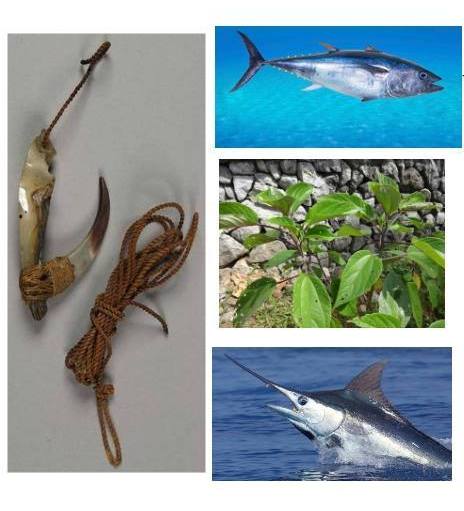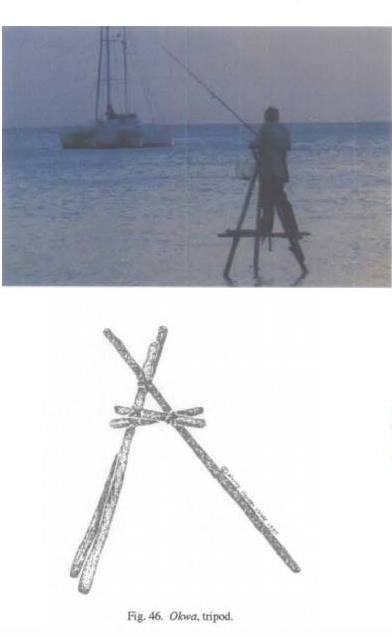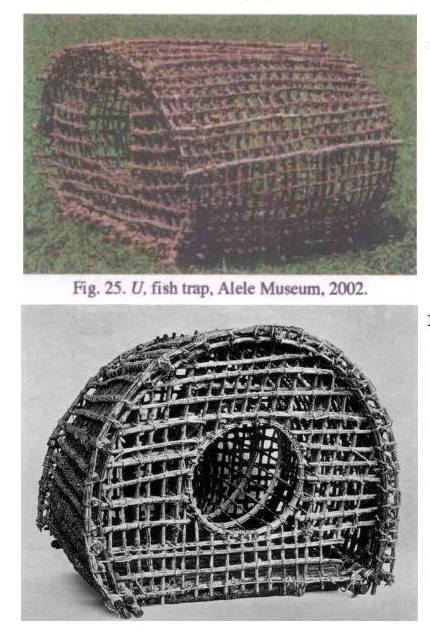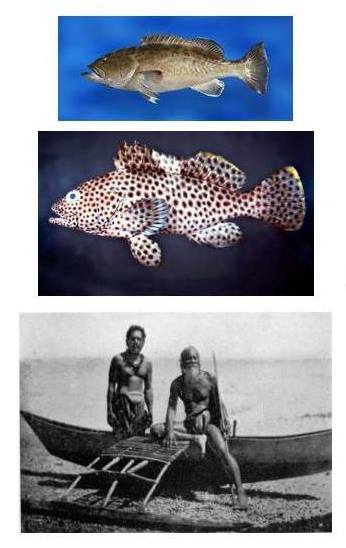Here is the 2nd post on traditional Marshallese fishing methods. This week reviews a few individual fishing methods
Boro
The boro was a fish trap. It was similar to the u (see below) but has conical or cylindrical shape. Pandanus roots lie over 30 or more rings and were tightly fastened at every point of contact. A funnel was not present at the entrance, as found in the u. One end was closed by a small net or by sticks laid crosswise or by concentric cords laid in the shape of a star.
Latippãn
The style of bottom fishing know as latippãn was used to catch fish like marlin or tuna in the deepest waters during the calmer summer months. The fishing line was traditionally made from the bark of a armwe tree and was as long as 200 feet. Hooks carved from oyster shelves were used and mamo (a type of sardine) were used as bait. This method required special skills and stamina since the fish would drag the fisherman long distances. The fishermen would tire out the fish until it is ready to give up.

Okwa
Okwa is a fishing technique said to have originated in kabin meto. It is a tripod made of mangrove stakes for the fisherman to stand on to fish in order to not disturb the fish in the water. The okwa would be placed in the shallow parts of the lagoon. The fisherman would use a hook, line, or spear when fishing from the okwa. Jo or goatfish was typically caught with this method.

Tuwa
Tuwa or tuwe is the Marshallese term used for spearfishing (made bu). The fish usually caught in this method of fishing range from mone to bilak, kwi, kobat and many other varieties. The speared fish is not released at first, but is kept in its pierced pose since the fisherman uses it as a bait by holding it down next to the coral heads to attract the other fish. A fisherman can spearfish any time during the day or night (although there is more chance of catching more fish during the night), anytime of the year, except when there are storms. This type of fishing is popular at present time since it has been enhanced with the additional use of rubber, snorkels and fins and even SCUBA diving gears. Lippin is similar to spearfishing; however, diving may not be necessary for this kind of fishing.
U (Wooden fish trap)
The u (or wu) was a fish trap that is submerged in 15-30 feet of water and left for at least 5 days. The trap is made of twigs of kōñe (ironwood tree) and bob (pandanus) aerial roots, bent like hoops and lashed together with ekkwal (coconut sennit rope). There was a round entrance in the middle of the front wall that allowed fish to swim into the basket. To keep the fish from escaping a funnel of rings and sticks gradually close in from the entrance. A small side door is used to remove the fish. Fish caught with this technique range from mone (unicorn fish) to kuru (grouper).

Urōk
Urōk is a bottom fishing method requiring a canoe / boat using 1/2 – 1 inch fish hooks with no poles. This method was useful for catching reef fish such as girro (grouper) and ledjipdjip (high fin grouper) . Strong fishing lines were made from the armwe tree and lures were cut from oyster shells. Hermit crabs, ghost crabs or sardines were used for bait.

Some other individualized methods were: rojep, kadjo and eoojjaak (Rupe Om).
The above is adapted from the sources below and from the Marshallese consulate in Honolulu, Hawaii. In the Fall of 2018 the consulate posted several pieces on culture to celebrate Manit day on their facebook page.
References:
- Marshallese Consulate in Hawaii, Face book page. www.facebook.com/rmi.hcg Sept 2018
- Allele museum, Majuro, MH
- Etto n̄an Raan Kein: A Marshall Islands History. by Julianne M. Walsh, Ph.D.; in collaboration with Hilda C. Heine, Ed.D.; with the assistance of Carmen Milne Bigler, Mark Stege. 2012. 526 pp.
- Pacific Digital Library: Marshallese Traditional Fishing Methods. http://www.pacificdigitallibrary.org/cgi-bin/pdl?e=d-000off-pdl–00-2–0–010—4——-0-1l–10en-50—20-text—00-3-1-00bySR-0-0-000utfZz-8-00&a=d&cl=CL1.8&d=HASH01e304140308e8542cdc3ae6.1
